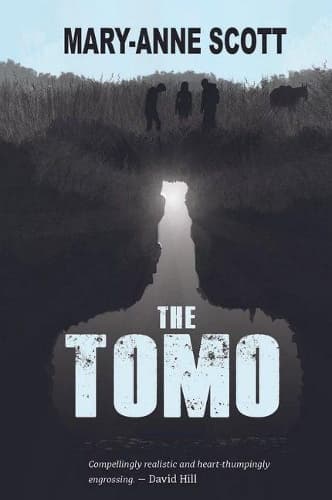Review: The Tomo
Reviewed by Sarah Forster
Mary-anne Scott is close to taking Aotearoa’s crown for best-written young men with this, her fifth book for young adults.
The Tomo - named for the naturally-occurring holes in volcanic land - is set at a farm near Gisborne, where Phil has been sent by his family to work for a couple of weeks during Christmas while his mum takes his dad to Wellington for cancer treatment.
Phil is the middle child, with an older brother Skip and a younger brother Oliver. With glasses and a skinny frame, he doesn’t quite have what he considers to be the farmer physique. He doesn’t want to go, so to sweeten the deal his dad puts him in charge of their farm dog Blue. Blue is an unusual dog, with heterochromia and an “expressive face”—she is as much a pet as a working dog.
He gets to the farm and while farm worker Kōtuku is a nice guy, he finds farm boss Chopper gruff and unfriendly. Because Blue responds to verbal commands rather than whistles, Phil is stuck cleaning shearing sheds and grubbing thistles.
He’s miserable but finds sanctuary in the friendship of Chopper’s step-daughter Emara, making the weeks at the farm more appealing.
Phil is a completely real teen—while he occasionally considers his father’s illness early in the book and he worries for his mum when she lets her brave front slip—he is a fairly typical self-absorbed kid. When he gets a message from his mum that his dad is heading home a little early and she wants Blue back, he chooses to ignore it for a day because he doesn’t want to let his mate go.
Each chapter of the book is introduced with a diagram of a knot and the name of the knot. While the knots aren’t an essential part of the story, they act as a symbol of how Phil copes with uncertainty. “You never know, a knot might be the difference between life and death.”
Non-obvious foreshadowing is my favourite type of foreshadowing.
The author’s skill at world-building is also great, making me feel like I was there with Phil all the way. “A smaller path led away from his track and Phil veered left to follow it, noticing immediately that the landscape changed dramatically from the open hills, with Whakapūnake dominating the sky line to an area of thick bush.”
The story recognises the Māori ancestry of the land and the author acknowledges her cultural advisors. Remarkably, the story is based on a true story passed down in Mary-anne’s family. This is significant in context of settler publishing and all of our stories of the land ought to be as respectful.
Another excellent element of the story was the way in which Mary-anne depicts the familial relationships. Skip teases his brother, calling him ‘Smif’, short for ‘small fifteen’ but while they don’t have much in common he is there for him when he needs help.
And he does. On the fateful day of the muster, Blue is sent after a ram—and disappears. Phil immediately finds the tomo she disappeared into and works out how deep it is. While Chopper is ready to give her up, Phil knows he can’t let her go that easily. But he has to draw deeply on his reserves of courage, and work more closely than ever before with Skip, to save her.
Despite some heavy themes, this book would suit readers from age 11 up—great for advanced readers who aren’t ready for the more adult themes that YA books often have.
Reviewed by Sarah Forster
